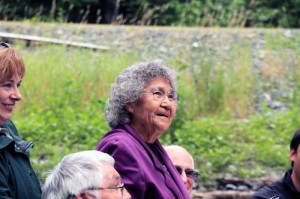By Dustin Solberg, The Nature Conservancy
A Haida elder named Viola Burgess made history on this day. We were on the banks of a newly restored salmon stream in Alaska, where dozens of people had come from near and far to celebrate as wild salmon splashed their way upstream in crystalline water. Viola had renamed the stream, once so damaged it was thought to be beyond repair.
“Several years back, we were kind of unhappy about the name Fubar,” she told me, using the name it earned after the logging heydays in the Alaska panhandle. “I didn’t know the meaning of it for a long time. And when I did hear it, I said ‘change it’. We wanted something of beauty.”

Viola speaks from a powerful place. In the matrilineal society of the Haida, Viola holds the title of Clan Mother of the Raven Double-Fin Killer Whale Women. Her words carried an immeasurable weight, though as she ambled down the forest path that day, her light step barely scuffed the gravel beneath her feet.
Salmon and People
The day was about celebrating the return of the stream’s integrity: reversing its ugly name and making it right for wild salmon—the keystone species of the Tongass coastal rainforest. Bears, bald eagles, and orcas eat salmon, and the list goes on.
Salmon is also what sustains the people of the Tongass. Viola herself told me that when she asked her centenarian uncle to reveal the secret of his health, he replied with a simple answer: eating salmon every day.
The logging heydays were rough on salmon streams in the Tongass, and nowhere was this more true than on Prince of Wales Island. Trees grow big here, and the forests provided giant pulp mills with a steady stream of fiber – but at a cost.
Though logging brought jobs and more people to this remote region of Alaska, early logging practices simply weren’t sound. Forests and streams took a hit. Now, restoration opportunities abound, which could lead to jobs for local people and better fish and wildlife habitat.
Today we know the stream was not beyond repair. Restoration is complete, thanks to the National Forest Foundation, U.S. Forest Service, and The Nature Conservancy. Crews of heavy equipment operators from S & S General Contractors did the heavy work of moving rocks and logs.
Restoring More than a Stream
Now, with the stream restored, the Haida name selected by Viola is a fitting one: Gaandlaay Haanaa. In her Haida language, it means Beautiful River. Village of Hydaburg Mayor Anthony Christianson, a carver in the traditional Haida style, made a sign of red cedar and yellow cedar. It now proclaims the name for all to see.
Because the salmon streams of the Tongass National Forest supply a third of the U.S. wild salmon catch, some say the real value of the forest lies in its streams. For this reason, some call it a salmon forest.
The Tongass is also a Native place, where traditions run deep. “Our entire life cycle depends on the salmon life cycle,” Anthony says. “Without the salmon in this region we’d probably not exist.”
For people to thrive here, the salmon must thrive. And for salmon to thrive, people must thrive. As Viola has taught us, it takes a village to do conservation right.
Note: Elder Viola Burgess passed away in December, 2011.
With her family’s permission, we share her words with you in a video, “Making Fubar Beautiful: Restoring Salmon Streams in Alaska’s Tongass,” that records the incredible sentiments of that celebratory day last fall, when people came together with feasting and dancing to rightfully give a respectful name to a restored salmon stream.
The Nature Conservancy is the leading conservation organization working around the world to protect ecologically important lands and waters for nature and people.




